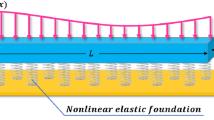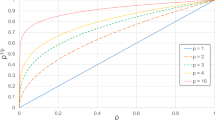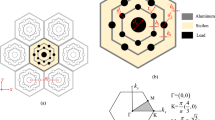Abstract
This research applies a layerwise theory to topologically optimize laminate composite. As laminate composite structures are consisted of many thin layers, some limitations exist in analyzing and optimizing based on linear plate or shell theory. To overcome these limitations and problems, various layerwise theories have been developed. Thus, more accurate solutions can be efficiently obtained by these layerwise theories. In this research, one of the layerwise theory is applied to topologically optimize laminate structures. In the forward analysis for structural displacements, it is possible to efficiently conduct a numerical analysis and the sensitivity analysis in topology optimization. By solving several numerical examples, we observed that the directions of optimal layouts are different from each other depending on the type of load applied. Also, various design shapes were drawn to complement the difference in stiffness due to the rotation of each layer. In addition, an analysis of how the various combinations of angles and their position affect the stiffness was also discussed in this study.
Similar content being viewed by others
References
J. N. Reddy, Mechanics of Laminated Composite Plates and Shells, Theory and Analysis, CRC Press (2004).
N. P. Suh, Axiomatic Design and Fabrication of Composite Structures: Applications in Robots, Machine Tools, and Automobiles, Oxford University Press (2005).
X. Zhou, A. Chattopadhyay and H. S. Kim, An efficient layerwise shear–deformation theory and finite element implementation, Journal of Reinforced Plastics and Compos–ites, 23 (2004) 131–152.
R. Mindlin, Influence of rotary inertia and shear on flexural motions of isotropic elastic plates, Journal of Applied Mechanics–Transactions of the ASME (1951).
J. Whitney and N. Pagano, Shear deformation in heterogeneous anisotropic plates, Journal of Applied Mechanics, 37 (1970) 1031–1036.
J. N. Reddy, A simple higher–order theory for laminated composite plates, Journal of Applied Mechanics, 51 (1984) 745–752.
A. Chattopadhyay and H. Gu, New higher order plate theory in modeling delamination buckling of composite laminates, AIAA Journal, 32 (1994) 1709–1716.
E. Barbero, J. Reddy and J. Teply, General two–dimensional theory of laminated cylindrical shells, AIAA Journal, 28 (1990) 544–553.
J. Reddy, A generalization of two–dimensional theories of laminated composite plates, International Journal for Numerical Methods in Biomedical Engineering, 3 (1987) 173–180.
A. Toledano and H. Murakami, A composite plate theory for arbitrary laminate configurations, Journal of Applied Mechanics, 54 (1987) 181–189.
K. M. Rao and H.–R. Meyer–Piening, Analysis of thick laminated anisotropic composite plates by the finite element method, Composite Structures, 15 (1990) 185–213.
E. Carrera, Evaluation of layerwise mixed theories for laminated plates analysis, AIAA Journal, 36 (1998) 830–839.
D. Sciuva, An improved shear–deformation theory for moderately thick multilayered anisotropic shells and plates, Journal of Applied Mechanics, 54 (1987) 589–596.
K. Bhaskar and T. Varadan, A higher–order theory for bending analysis of laminated shells of revolution, Computers & Structures, 40 (1991) 815–819.
P. B. Xavier, K. Lee and C. Chew, An improved zig–zag model for the bending of laminated composite shells, Composite Structures, 26 (1993) 123–138.
H. S. Kim, X. Zhou and A. Chattopadhyay, Interlaminar stress analysis of shell structures with piezoelectric patch including thermal loading, AIAA Journal, 40 (2002) 2517–2525.
H. S. Kim, A. Chattopadhyay and A. Ghoshal, Characterization of delamination effect on composite laminates using a new generalized layerwise approach, Computers & Structures, 81 (2003) 1555–1566.
H. S. Kim, A. Chattopadhyay and A. Ghoshal, Dynamic analysis of composite laminates with multiple delamination using improved layerwise theory, AIAA Journal, 41 (2003) 1771–1779.
O. Sigmund, A 99 line topology optimization code written in Matlab, Structural and Multidisciplinary Optimization, 21 (2001) 120–127.
K. Suzuki and N. Kikuchi, A homogenization method for shape and topology optimization, Computer Methods in Applied Mechanics and Engineering, 93 (1991) 291–318.
M. P. Bendsoe and O. Sigmund, Topology Optimization: Theory, Methods, and Applications, Springer Science & Business Media (2013).
M. P. Bendsøe and N. Kikuchi, Generating optimal topologies in structural design using a homogenization method, Computer Methods in Applied Mechanics and Engineering, 71 (1988) 197–224.
G. H. Yoon, J. S. Jensen and O. Sigmund, Topology optimization of acoustic–structure interaction problems using a mixed finite element formulation, International Journal for Numerical Methods in Engineering, 70 (2007) 1049–1075.
G. H. Yoon, Topology optimization for turbulent flow with Spalart–Allmaras model, Computer Methods in Applied Mechanics and Engineering, 303 (2016) 288–311.
G. H. Yoon, J. H. Kim, K. O. Jung and J. W. Jung, Transient quasi–static Ritz vector (TQSRV) method by Krylov subspaces and eigenvectors for efficient contact dynamic finite element simulation, Applied Mathematical Modelling, 39 (2015) 2740–2762.
G. H. Yoon, Stress–based topology optimization method for steady–state fluid–structure interaction problems, Computer Methods in Applied Mechanics and Engineering, 278 (2014) 499–523.
J. W. Lee, G. H. Yoon and S. H. Jeong, Topology optimization considering fatigue life in the frequency domain, Computers & Mathematics with Applications, 70 (2015) 1852–1877.
G. H. Yoon, Maximizing the fundamental eigenfrequency of geometrically nonlinear structures by topology optimization based on element connectivity parameterization, Computers & Structures, 88 (2010) 120–133.
W. Hansel and W. Becker, Layerwise adaptive topology optimization of laminate structures, Engineering Computations, 16 (1999) 841–851.
W. Hansel, A. Treptow, W. Becker and B. Freisleben, A heuristic and a genetic topology optimization algorithm for weight–minimal laminate structures, Composite Structures, 58 (2002) 287–294.
M. Bruggi, G. Milani and A. Taliercio, Design of the optimal fiber–reinforcement for masonry structures via topology optimization, International Journal of Solids and Structures, 50 (2013) 2087–2106.
S. N. Sørensen and E. Lund, Topology and thickness optimization of laminated composites including manufacturing constraints, Structural and Multidisciplinary Optimization, 48 (2013) 249–265.
G. P. Rodrigues, J. Guedes and J. Folgado, Combined topology and stacking sequence optimization of composite laminated structures for structural performance measures, 4th Engineering Optimization Conference (2015).
S. R. Henrichsen, Optimization of Laminated Composite Structures, Aalborg Universitet (2015).
P. Coelho, J. Guedes and H. Rodrigues, Multiscale topology optimization of bi–material laminated composite structures, Composite Structures, 132 (2015) 495–505.
C. J. Rupp, A. Evgrafov, K. Maute and M. L. Dunn, Design of piezoelectric energy harvesting systems: A topology optimization approach based on multilayer plates and shells, Journal of Intelligent Material Systems and Structures, 20 (2009) 1923–1939.
B. Zheng, C.–J. Chang and H. C. Gea, Topology optimization of energy harvesting devices using piezoelectric materials, Structural and Multidisciplinary Optimization, 38 (2009) 17–23.
C. Y. Kiyono, E. C. N. Silva and J. Reddy, Design of laminated piezocomposite shell transducers with arbitrary fiber orientation using topology optimization approach, International Journal for Numerical Methods in Engineering, 90 (2012) 1452–1484.
C. Kiyono, E. Silva and J. Reddy, Optimal design of laminated piezocomposite energy harvesting devices considering stress constraints, International Journal for Numerical Methods in Engineering, 105 (2016) 883–914.
K. Svanberg, The method of moving asymptotes—a new method for structural optimization, International Journal for Numerical Methods in Engineering, 24 (1987) 359–373.
Author information
Authors and Affiliations
Corresponding author
Additional information
Recommended by Associate Editor Kyeongsik Woo
Jong Wook Lee received his B.S. degree in Mechanical Engineering from Kyungpook National University, Daegu, Korea in 2010. He got his Ph.D. degree in the Department of Mechanical Engineering, Hanyang University. His research interests include topology optimization, static failure and dynamic failure, composite material.
Jong Jin Kim received his B.S. degree in Mechanical Engineering from Gangneung Wonju National University, Gangwon, Korea in 2017. He is currently a student at School of Mechanical Engineering, Hanyang University, Seoul, Republic of Korea. His research interests are topology optimization and composite material.
Heung Soo Kim received his B.S. and M.S. degrees in the Department of Aerospace Engineering from Inha University, Korea in 1997 and 1999, respectively. He got his Ph.D. degree in the Department of Mechanical and Aerospace Engineering from Arizona State University in 2003. He is now working a Professor in the Department of Mechanical, Robotics and Energy Engineering, Dongguk University. His main research interests are in biomimetic actuators and sensors, smart materials and structures as applied to aerospace structures and vehicles.
Gil Ho Yoon received his B.S. degree in Mechanical and Aerospace Engineering from Seoul National University in 1998. And he received his M.S. and Ph.D. degrees in Mechanical and Aerospace Engineering from Seoul National University in 2000 and 2004, respectively. Dr. Yoon is currently a Professor at School of Mechanical Engineering, Hanyang University, Seoul, Republic of Korea.
Rights and permissions
About this article
Cite this article
Lee, J.W., Kim, J.J., Kim, H.S. et al. Application of a layerwise theory for efficient topology optimization of laminate structure. J Mech Sci Technol 33, 711–719 (2019). https://doi.org/10.1007/s12206-019-0125-4
Received:
Revised:
Accepted:
Published:
Issue Date:
DOI: https://doi.org/10.1007/s12206-019-0125-4




